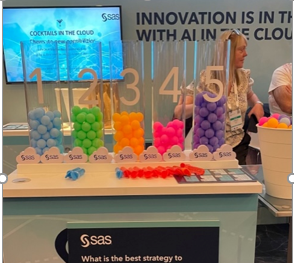This is the third post in a series about the Gartner Data & Analytics Summit in London.
Welcome to the third and final collection of thoughts inspired by my time covering the SAS booth at the Gartner Data & Analytics Summit in London. In my previous blog, I talked about the Wisdom of the Crowd.
Now I want to address the question “What do you think are the challenges or barriers to moving analytics to the Cloud?”. We asked visitors of the Gartner Summit to vote for the following:
 Complexity/range of offerings.
Complexity/range of offerings.- Legacy integration.
- Control of costs.
- Data security/governance.
- Always-on availability.
Looking at the results, it looks like there were three tiebreakers. So, let’s tune into each of these three challenges.
Data security and governance
Security is an obvious public concern regarding the use of cloud compared with traditional on-premises deployment, which is better understood. Public cloud vendors and SAAS providers have security certifications, showing how seriously they take this topic. You might wonder if your own on-premises data center would survive the same testing scenarios that are performed to obtain those certifications.
Despite this, we also have customers for whom a move to the cloud may be premature, perhaps slowed by an industry regulator or organizational caution. Using analytics in the cloud introduces no more risk than any other workload. As we’ll explore later, analytics needs data – sometimes a lot of data, and it may be sensitivities regarding the use of data beyond the data center that slow the transition to the cloud.
If a move to the cloud is not on your horizon, SAS Viya, although designed to run in the cloud using containers, can be equally deployed on-premises in an OpenShift environment. Deploy on-premise and it’s a much easier step to lift to the cloud. As an aside, from an on-premises SAS landscape, you can deploy SAS and Python models to run in the cloud by publishing models and decision logic into a standalone container (SAS Container Runtime) which is called using a REST API. See here for how to do this.
Legacy integration
At first glance, you might assume that moving analytics to the cloud should be easy because it’s a stand-alone workload and potentially easier to relocate. This has been the case for other discrete activities such as HR & expense processing which have enjoyed early cloud adoption, accelerated by using vendor SAAS offerings.
Much of the discussion around legacy integration has been about the location of data, rather than the software or hardware used to manage it. Analytics relies on data and ideally you want to run analytics as close to the data as possible. While one can deploy a cloud-based analytics platform that uses on-premises data, you may find much of your time is spent shunting data back & forth. And let’s hope you’re not also incurring ingress/egress costs for these data transfers. If the volumetrics are modest or where the computing effort of the analytics far exceeds the transfer time, this remains a viable approach – despite its limitations.
If you need access to broader data and larger volumes, you may be at the mercy of your organization’s enterprise data strategy and tied to their timeframe for moving to the cloud. The best candidates (for early migration to the cloud) are analytics use cases whose data requirements can be satisfied by data that is already in the cloud. Even better is to find a use case that has yet to be delivered and use its business case to start afresh in the cloud.
Seamless access to data has been a foundation capability of SAS since its inception, and this holds true in the cloud era as well. A useful list of 60+ current data sources supported by SAS Viya can be found here.
Control of costs
According to Gartner, public cloud spending will exceed 45% of all enterprise IT spending by 2026, up from less than 17% in 2021. While this suggests that the appetite for the cloud remains strong, there is a growing realization that moving to cloud adoption offers many benefits. But there’s no guarantee that it will necessarily be a cheaper way to deliver. Perhaps this is what the Gartner participants were thinking about when they voted.
The assumption that you can downsize or even shut down your analytics platform overnight is admirable, but our experience shows that such savings are not the main objective today. Although SAS Viya supports resource elasticity to some extent, many organizations have not yet explored this possibility.
In the last couple of years, SAS has been running an annual global Hackathon that runs for a full month with dozens of competing teams participating from different time zones, each with their own SAS Viya deployment. We use the public cloud to deliver the required infrastructure: taking advantage of the flexibility to spin up or down new environments and the scalability to accommodate new teams. Increasingly we are witnessing organizations not running their entire analytical workloads on a single analytics platform. Instead, modern landscapes include sandboxes; development environments and the use of in-database processing and so on – each with different up-time and scaling requirements.
Final Thoughts
At this point, you may still be wondering about the title of this post which reflects the need for thoughtful planning when migrating analytics to the cloud.
The movement to the cloud is a clear one and with seemingly unstoppable momentum. Analytics in the cloud can be effectively delivered, usually, in a phased manner that recognizes some of the challenges briefly considered here. I encourage you to be friendly with your local architect, who can make a huge impact on the overall success of any cloud migration!
This concludes our series of three blogs from the Gartner summit. Thank you if you visited our stand and voted. You can see that we listened and were inspired to share our own thoughts as well.

